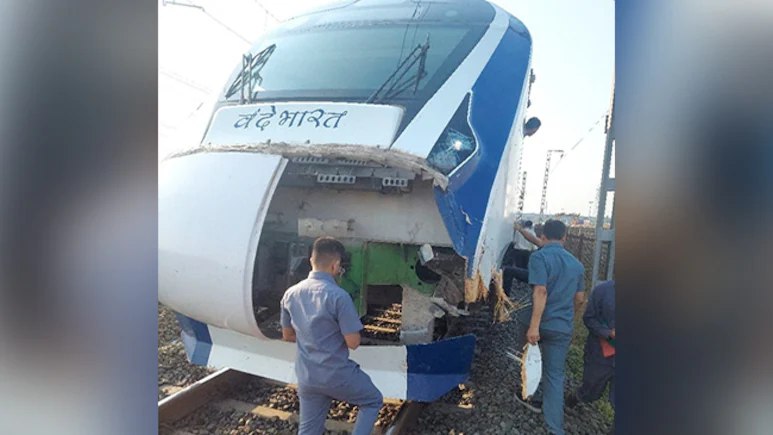“High Speeds…”: Railways Bats For Vande Bharat Amid Safety Concerns

Vande Bharat Trains: Addressing Safety Concerns and Cattle Collisions
Since its launch in February 2019, India’s Vande Bharat trains have garnered attention, not just for their speed and innovation, but also for incidents involving cattle. This has prompted significant efforts to enhance safety, including fencing over 3,500 km of tracks.
Vande Bharat, Indian Railway’s flagship service and the country’s first indigenously designed and manufactured semi high-speed train, boasts several safety features, including Kavach, a state-of-the-art automated train protection system, Southern Railway clarified Monday evening.
Railway Safety Authority Flags Potential Risks
A report by the Commission of Railway Safety, a statutory body acting as the railway safety authority, highlighted potential risks of serious accidents if a Vande Bharat train, typically running at speeds up to 160 km per hour, collides with cattle.
The report also raised concerns about the weight of the first coach, suggesting it may be more susceptible to damage in high-speed collisions.
This report is particularly significant given the Railways’ plans to operate even regular trains at speeds of up to 160 km per hour, emphasizing the need for robust safety measures.
Southern Railway’s Response: Focus on Impact Absorption
“High speeds, enhanced safety standards, and world-class service are the hallmarks of this train,” Southern Railway stated from its Chennai HQ, emphasizing the Vande Bharat’s distinctive cone-shaped nose designed to deflect impact energy.
Key Safety Features: Nose Cone and Cattle Guard
The front nose cone is designed to absorb energy in case of cattle hit. It is made of material that crumbles and absorbs impact energy. For additional safety, there is a cattle guard at the front to deflect anything that comes on the track, the release explained.
“Exactly for that reason, cattle hits have not led to major disasters.”
Measures Taken to Prevent Cattle Collisions
In January 2023, following several incidents, Western Railways began erecting metal barriers along the 620-km Mumbai-Ahmedabad route, costing nearly Rs 243 crore.
Since then, Railway officials report that over 3,500 km of tracks have been fenced.
Furthermore, recommendations have been made to eliminate level crossings on Vande Bharat routes.
Additional Safety Recommendations
- Deploying RPF (Railway Protection Force) personnel at spots frequented by cattle.
- Building subways for animal movement.
Vande Bharat’s Extensive Operation and Future Plans
Chief Public Relations Officer M Senthamil Selvan highlighted the Kavach system, noting that Vande Bharat trains have traveled around 3.5 crore kilometers, approximately 870 times the Earth’s perimeter, proving to be “safe and efficient.”
As of December, there were over 136 Vande Bharat services.
During the presentation of the budget in February, Railways Minister Ashwini Vaishnaw announced plans for 200 new Vande Bharat trains as part of an initiative to expedite rail travel.
With input from agencies
